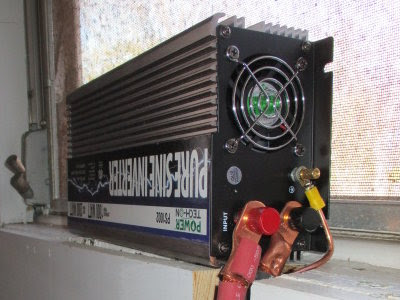 |
| Back porch: freezer, inverter, solar panels in background. |
After all the excitement, anticipation, and build-up, solar power day was exceedingly uneventful. Switching our deep freezer from the grid to our solar electric system was just a matter of closing a circuit breaker, moving the plug from one socket to another, and turning on the inverter.
 |
| The back of the inverter with freezer plugged in. |
We checked the freezer light—all systems go. Now we monitor.
 |
| Charge controller read-out screen. |
There are two things we're keeping an eye on. One is how many amp-hours our freezer will use during a 24-hour cycle. We have 705 amp-hours stored in our battery bank, so we need to know how long the bank alone can keep the freezer running during a string of sunless days. The charge controller keeps track of this, so I must become familiar with the 100-page section in the manual dealing with reading the summary screens.
 |
| Charge controller manual |
The other thing to monitor is the battery State of Charge (SoC). This is the percentage of energy still available in the battery bank. SOC varies by battery, so the exact numbers must be obtained from the manufacturer. Obviously, the goal is to not drain the batteries too low. This is of the utmost importance, because it relates directly to the life and longevity of the batteries.
My very first deep cycle battery was sealed, so I learned to check SoC by monitoring battery voltage. Turns out, it's more complex than that! To be accurate, the specific gravity of the batteries needs monitoring. This should be checked with regular maintenance anyway, but the voltage is an indicator, so we'll keep an eye on that. Most folks seem to use 50% as their bottom line, but others don't let their batteries drain that low to increase battery longevity.
What's surprising is that the 50% doesn't refer to voltage; it refers to battery chemistry. So for a 12-volt battery, 50% SoC isn't 6 volts, it's 12.10. That's why measuring the specific gravity is more accurate. But voltage is an indicator, so it's a quick and helpful way to keep an eye on things. Readings are always taken when the batteries are at rest, i.e. neither charging nor discharging.
Everyone who has gone to solar says the learning curve is such that everybody kills their first battery bank. We've done our best due diligence, so I sincerely hope that's not the case for us. But I know better than to assume anything!
I'm monitoring a few other things too. One is back porch room temp. For that I have a fridge and freezer thermometer that records highs and lows.
 |
| I like that these can be switched from °F to °C. |
It came in a two-pack, so I have one on the porch and one in the pantry. I can monitor these rooms to get an idea of the temperature range during a particular season. They'll help us evaluate experiments to keep the rooms cooler.
I also bought two probe thermometers for monitoring the internal temps of freezer and upcoming chest fridge.
 |
| These come in Fahrenheit or Celsius only. |
With a probe, I don't have to open the freezer or fridge door to check its temp. I've learned that my freezer turns on when the internal temp gets above 4.5°F (-15.3°C). It turns off when it reaches -11°F (-23.9°C). I'm sure that's fascinating information! LOL
Of course, we're curious how much we'll save on our electric bill. We still have a few more days left in the January billing cycle, so we really won't know the answer to the question until early March, when we get February's full bill. I'm expecting it will drop somewhat with the freezer now on solar, and even more once we get rid of my pantry fridge, an old energy guzzler. We plan to replace it with a chest fridge soon (watch this blog for more on that!)
When we started homesteading ten years ago, we wanted alternative energy, but for many years that seemed impossible. Step-by-step here we are. It's not what we originally envisioned, but it's good. Like all technology it isn't perfect, but it meets a true need, and that's what's important.
The next step is the chest refrigerator, and then we'll turn to phase 2 of our three-part plan to increase food storage efficiency: improving the pantry.
See also "Chest Freezer to Fridge Conversion."
Solar Power Day © January 2020

















































